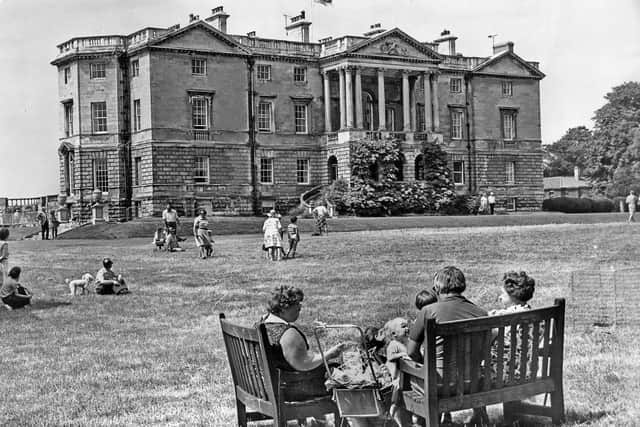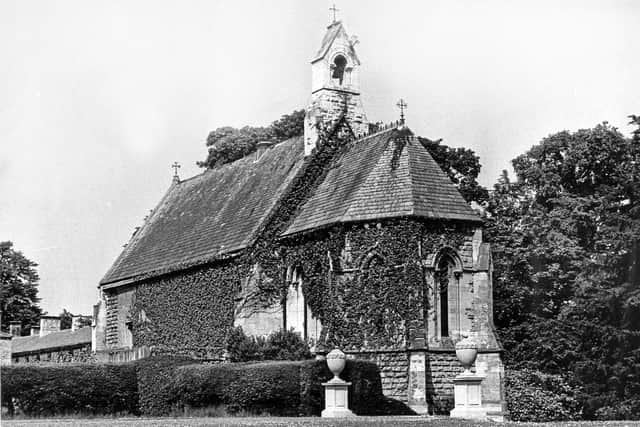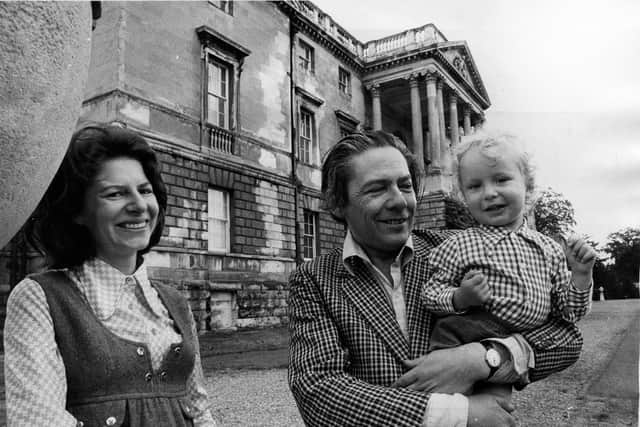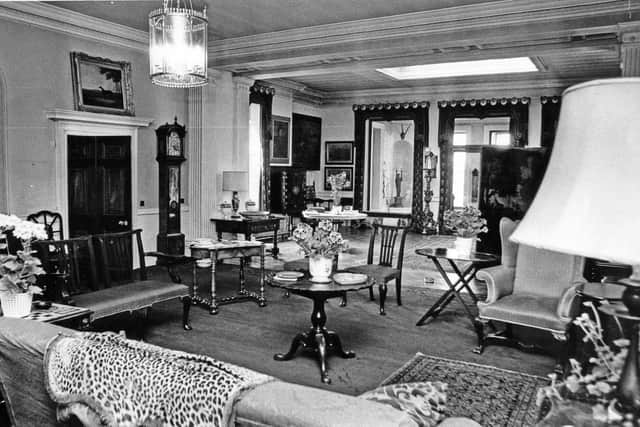Sandbeck Park, Rotherham: The impressive Yorkshire country house occupied by the Earl of Scarborough
Robert Saunderson acquired the Sandbeck manor in 1549 from Richard Turke who had purchased it around the time of the dissolution of the monasteries. Prior to that, it had been, from 1241, the property of Roche Abbey. Robert’s son, Sir Nicholas Saunderson, built the first house at Sandbeck around 1626.
On the death of James Saunderson, the 5th Viscount and 1st Earl of Castleton, in 1723, his estates passed to his maternal cousin Thomas Lumley. This included his large holdings in Lincolnshire and Yorkshire, and the houses at Glentworth and Sandbeck. Lumley became 3rd Earl of Scarbrough on the death of his elder brother and he also inherited the family’s ancestral home Lumley Castle in Durham. He died in 1752. His son Richard, 4th Earl of Scarbrough, took up residence with his wife at Glentworth with intention of rebuilding it. He employed James Paine to produce plans and these were dated 1753. But this project was abandoned in favour of rebuilding Sandbeck. The 4th Earl’s wife had declared Sandbeck to be ‘inexpressibly charming’.
Advertisement
Hide AdAdvertisement
Hide AdAmongst Paine’s work in Yorkshire before this time was Nostell Priory c.1737-50 and the Doncaster Mansion House, 1745-49. He also undertook work at Chatsworth House 1756-67.


According to Peter Leach in James Paine (1988), the architect was first consulted about remodelling Sandbeck in 1757 but the work was not approved until 1763. Leach adds: ‘Paine’s remodelling was comprehensive and left few indications that the house was not a completely new one.’ The designs for the kitchen, stables and garden buildings appeared in 1765-66. Much of the work was completed by 1767. Working with Paine at Sandbeck were William Collins and Joseph Rose, the elder.
The 4th Earl turned his attention in the 1770s to remodelling Roche Abbey. It had been owned by the Saunderson family from 1627 and was part of Thomas Lumley’s inheritance. For the work, the 4th Earl involved Lancelot ‘Capability’ Brown and paid him £2,800.
Stones for the rebuilding of Sandbeck allegedly came from the quarry at Roche Abbey.
Advertisement
Hide AdAdvertisement
Hide AdRichard Lumley, the 9th Earl of Scarbrough, was noted for being involved in a number of activities inside and outside the Sandbeck estate. Born at Tickhill Castle in 1813, he was educated at Eton and entered the army as a Cornet in the Hussars before retiring in 1837 as a Lieutenant Colonel in the West Yorkshire Yeoman Cavalry. Afterwards, he sat in the House of Lords until he inherited the family titles in October 1856. A year later, he engaged Scottish architect William Burn to make some significant internal alterations at Sandbeck. Then, around 1869 he hired Benjamin Ferrey, an ecclesiastical architect and pupil of Augustus Charles Pugin to build a private chapel at Sandbeck.


Towards the end of the 1870s, he appointed the architect James Whitton to design and layout a holiday resort on his estate at Skegness.
At the outset of the 20th century, Aldred Lumley, 10th Earl of Scarbrough born in 1857, was in charge at Sandbeck. He had succeeded to the title in 1884, was in the Boer War and, with his long experience, involved with the Territorials and the Volunteers.
Before the First World War, guests often stayed at Sandbeck or visited the house, particularly during Doncaster’s September Race Week. Events were also staged in the grounds.
Advertisement
Hide AdAdvertisement
Hide AdIn September 1900, members of the Scarbrough Habitation of the Primrose League took part in a social gathering at Sandbeck with over 600 attending to event. The grounds surrounding the hall were thrown open for inspection. The band of the Yorkshire Dragoons, of which regiment Lord Scarbrough was the commanding officer, played a programme of music.


A year later, a bazaar and garden fete were held in aid of a restoration fund for St Winifred’s Church, Stainton. The company was said to include ‘all classes of society attended, from the Earl and Countess of Scarborough down to a well-known drover from Tickhill’.
There was a Royal visitor on Saturday afternoon September 10 1904. King Edward VII travelled by motor car with Lady Savile and other guests from Rufford to visit the Earl and Countess of Scarbough. The Earl was one of his majesty’s A.D.C and the Lord Lieutenant of the West Riding. In September 1905, the Earl of Clarendon was a visitor.
Activities at Sandbeck continued during the inter-war years. The annual sports of the Yorkshire Dragoons were held in Sandbeck Park during May 1937 and was said to furnish thousands of spectators with plenty of thrills. The splendid horsemanship displayed by the riders was worthy of the traditions of the Army.
Advertisement
Hide AdAdvertisement
Hide AdA visitor to Sandbeck on September 13, 1938 was Queen Mary. She travelled from Harewood to take lunch with the Earl and Countess of Scarbrough.


Opening a garden fete during July 1939, the Earl of Scarbrough expressed the wish that he would always be able to keep open his home and all his people employed. The garden fete was in aid of a fund for providing the church of the Ascension Maltby with new heating apparatus. He said that conditions in England were changing. Properties were being broken up: big houses were derelict or being turned into institutions, in all parts of the country; and many had already been levelled to the ground. He had always felt that property owners living on their estates were a very useful means of distributing wealth.
The 10th Earl of Scarbrough died on March 4, 1945 aged 87. One obituary reported that he had taken a prominent part in establishing the South Yorkshire Coalfield Church Extension Scheme.
His nephew Sir Roger Lumley, former Governor of Bombay, was the heir. He was MP for East Hull from 1922 to 1929 and for York from 1931 to 1937.
Advertisement
Hide AdAdvertisement
Hide AdIn the post war years, members of the Royal Family visited Sandbeck. In an informal setting at the estate during September 1948, the King and Queen talked of coal mining, pit disasters and rescue work to 58 officials and miners – heroes of the previous year’s disasters at Barnsley Main and Thornhill, Dewsbury.
Immediately after Princess Elizabeth’s son had been born on November 14, 1948, the news was telephoned to Princess Margaret at Sandbeck where she was staying before opening the ‘Sheffield on its Mettle Exhibition’ the following day.
The Queen took lunch at Sandbeck whilst attending the September Race meeting at Doncaster in 1955. She was there again the following year. In 1958, the Queen Mother was a visitor as well as in 1962.
A report from October 20, 1956 said that in consequence of the demolition of a wing at Sandbeck a sale would be held during early November of various items including furniture and pictures.
Advertisement
Hide AdAdvertisement
Hide AdThe 11th Earl of Scarbrough died on June 29, 1969. His successor, the 12th Earl, was Richard Lumley born 1932. On opening Sandbeck Park to the public on Sunday July 20, 1975, he told the Sheffield Telegraph that he had not done this previously because of financial reasons. He was only opening it then because he wanted to raise money for a long-term preservation project he had devised.
The 13th Earl succeeded his father in 2004. He takes an active part in local charities, including serving as Patron of the Sheffield Royal Society for the Blind.
Please note. Sandbeck Park is NOT open to the public.
For further information see: M. Girouard, 'Sandbeck Park, Yorkshire I-III', Country Life, Oct 7th, 14th, 21st, 1965.
Comment Guidelines
National World encourages reader discussion on our stories. User feedback, insights and back-and-forth exchanges add a rich layer of context to reporting. Please review our Community Guidelines before commenting.